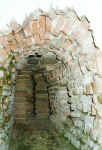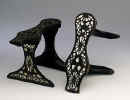3. Technological issues

The first Victorian Turkish baths were heated using the traditional Roman hypocaust—a practice also followed in baths built during the period of the Ottoman Empire.

However, this necessitated bathers wearing wooden pattens to avoid burning their feet and could be dangerous if someone slipped and was unable to get up immediately.

A later approach was to conduct the heated air behind the walls so that bathers were protected by seating, set slightly away from the walls.
Ventilation was a major problem. Effective electric fans were unavailable before the development of alternating current motors in the 1880s.6 A way had to be found of disposing of the stale sweat-laden air. Fresh cold air was drawn into the furnace room, heated as it passed over the furnace, escaping through a duct at the top—or, controversially at the bottom—of the laconicum, passing through the other hot rooms in turn until it passed, cool by now, outside the building through a ventilator.
This did not always produce the expected continuous flow of fresh hot air
because of the nature of the then commonly used cockle furnaces. These
 were designed to maximise the heat obtained by placing a large metal dome directly above an open furnace. The air was heated as it passed over the dome.7 Unfortunately the harsh heat gradually destroyed the dome and minute particles of metal were carried along with the air flow to be inhaled by the bathers.
were designed to maximise the heat obtained by placing a large metal dome directly above an open furnace. The air was heated as it passed over the dome.7 Unfortunately the harsh heat gradually destroyed the dome and minute particles of metal were carried along with the air flow to be inhaled by the bathers.
The invention of the Convoluted stove, in 1866,8 by two Turkish bath
 owners, Joseph Constantine and Thomas Whitaker, was a major improvement9 and this gradually became the industry standard, as well as being used to heat large buildings such as Manchester’s original Free Trade Hall. It does appear, however, that at least one improved cockle furnace survived, until the late 1940s, at Bartholomew’s baths in the City of Bath.
owners, Joseph Constantine and Thomas Whitaker, was a major improvement9 and this gradually became the industry standard, as well as being used to heat large buildings such as Manchester’s original Free Trade Hall. It does appear, however, that at least one improved cockle furnace survived, until the late 1940s, at Bartholomew’s baths in the City of Bath.

